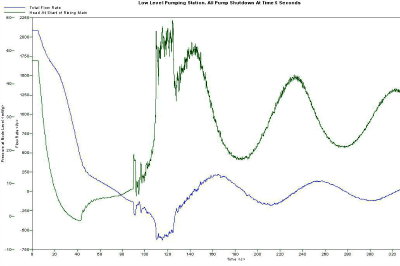
YouTube Water Hammer Explained
Explanation of transient flow and its effects
Transient flow, is flow where the flow velocity and pressure are changing with time. When changes occur to a fluid systems such as the starting or stopping of a pump, closing or opening a valve, or changes in tank levels, then transient flow conditions exist: otherwise the system is steady state. Often transient flow conditions persist as oscillating pressure and velocity waves for some time after the initial event that caused it.
Transient flow is usually referred to as surge or water hammer, and the terms are commonly interchanged. But strictly speaking surge is where the mass oscillation of the fluid is the dominating force and the compressibility of fluid is not significant, for example two connecting reservoirs oscillating up and down. Water hammer on the other hand is where the compressibility of the fluid has the dominant effect such as the sudden closure of a valve. Transient flow can result in significant transient pressures that may exceed the design limit of the pipes and fittings. Or it may be important to maintain a steady flow for example in the process industry. Therefore a detailed understanding of transient flow can be very important.
Transient flow problems are commonly solved using a finite difference method known as the method of characteristics and other similar methods. The equations generated by this methods can only readily be solved with a computer. There are a number of commercial software tools such as SimulationX and Flowmaster which can solve transient flow problems. However to use the tools requires a detailed understanding of the flow problem particularly the stiffness of the fluid, the pipe and the pipe supports as these effect the wave speed which has a dominant effect during water hammer.
At Fluid Mechanics we have many years’ experience in solving transient flow problems. We can provide advice on cost effective ways of minimising transient flow effects.
